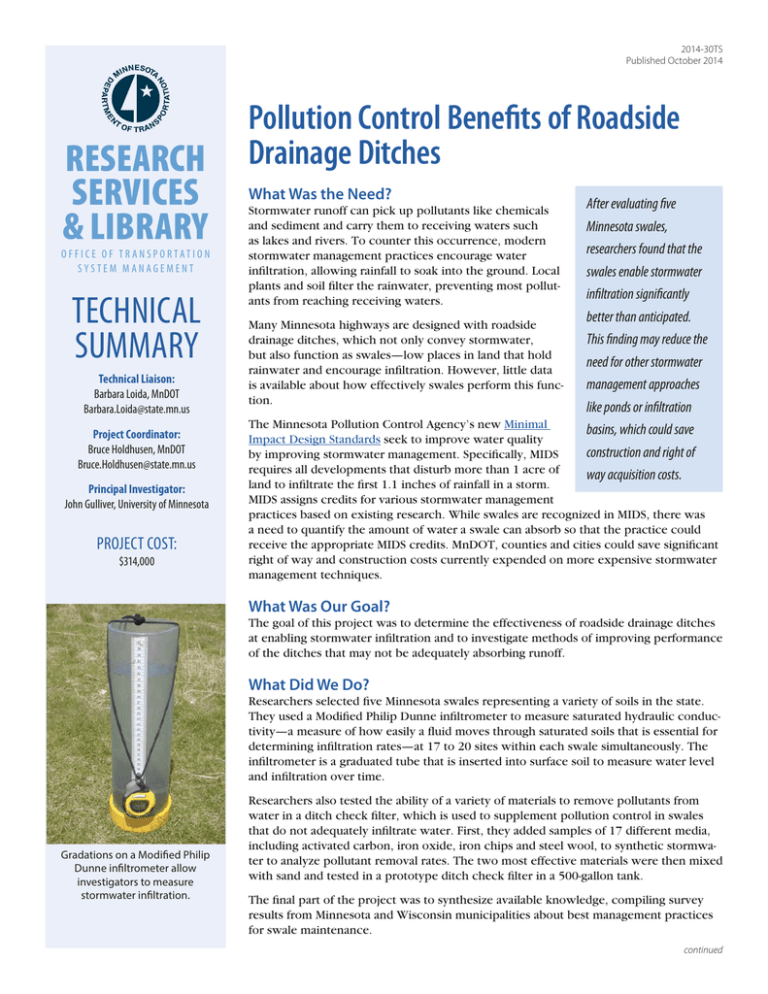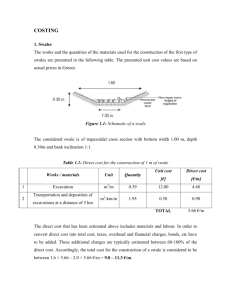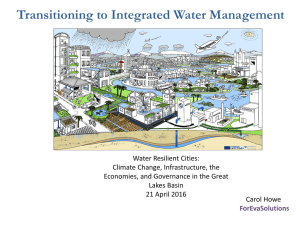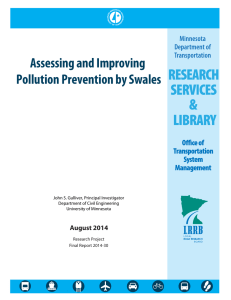RESEARCH SERVICES & LIBRARY Pollution Control Benefits of Roadside
advertisement

2014-30TS Published October 2014 RESEARCH SERVICES & LIBRARY O FFICE O F TR ANSP O R TATI O N SYSTEM MANAGEMENT TECHNICAL SUMMARY Technical Liaison: Barbara Loida, MnDOT Barbara.Loida@state.mn.us Project Coordinator: Bruce Holdhusen, MnDOT Bruce.Holdhusen@state.mn.us Principal Investigator: John Gulliver, University of Minnesota PROJECT COST: $314,000 Pollution Control Benefits of Roadside Drainage Ditches What Was the Need? Stormwater runoff can pick up pollutants like chemicals and sediment and carry them to receiving waters such as lakes and rivers. To counter this occurrence, modern stormwater management practices encourage water infiltration, allowing rainfall to soak into the ground. Local plants and soil filter the rainwater, preventing most pollutants from reaching receiving waters. Many Minnesota highways are designed with roadside drainage ditches, which not only convey stormwater, but also function as swales—low places in land that hold rainwater and encourage infiltration. However, little data is available about how effectively swales perform this function. After evaluating five Minnesota swales, researchers found that the swales enable stormwater infiltration significantly better than anticipated. This finding may reduce the need for other stormwater management approaches like ponds or infiltration basins, which could save construction and right of way acquisition costs. The Minnesota Pollution Control Agency’s new Minimal Impact Design Standards seek to improve water quality by improving stormwater management. Specifically, MIDS requires all developments that disturb more than 1 acre of land to infiltrate the first 1.1 inches of rainfall in a storm. MIDS assigns credits for various stormwater management practices based on existing research. While swales are recognized in MIDS, there was a need to quantify the amount of water a swale can absorb so that the practice could receive the appropriate MIDS credits. MnDOT, counties and cities could save significant right of way and construction costs currently expended on more expensive stormwater management techniques. What Was Our Goal? The goal of this project was to determine the effectiveness of roadside drainage ditches at enabling stormwater infiltration and to investigate methods of improving performance of the ditches that may not be adequately absorbing runoff. What Did We Do? Researchers selected five Minnesota swales representing a variety of soils in the state. They used a Modified Philip Dunne infiltrometer to measure saturated hydraulic conductivity—a measure of how easily a fluid moves through saturated soils that is essential for determining infiltration rates—at 17 to 20 sites within each swale simultaneously. The infiltrometer is a graduated tube that is inserted into surface soil to measure water level and infiltration over time. Gradations on a Modified Philip Dunne infiltrometer allow investigators to measure stormwater infiltration. Researchers also tested the ability of a variety of materials to remove pollutants from water in a ditch check filter, which is used to supplement pollution control in swales that do not adequately infiltrate water. First, they added samples of 17 different media, including activated carbon, iron oxide, iron chips and steel wool, to synthetic stormwater to analyze pollutant removal rates. The two most effective materials were then mixed with sand and tested in a prototype ditch check filter in a 500-gallon tank. The final part of the project was to synthesize available knowledge, compiling survey results from Minnesota and Wisconsin municipalities about best management practices for swale maintenance. continued “We discovered that Minnesota soils can infiltrate more water than we had anticipated. In a soil with low infiltration rates, like a mix of loam and clay, plant growth keeps the soil open and helps it infiltrate water much more quickly.” —John Gulliver, Professor, University of Minnesota Department of Civil, Environmental and Geo-Engineering Stormwater infiltration rates at five swales were significantly better than expected based on published rates. However, infiltration was not consistent across a swale because of natural variations in soil compaction and uneven water flow. What Did We Learn? “There’s a big push in Minnesota, and probably everywhere, to do more infiltration. We know that our ditches are doing some of that, but we wanted to look at how much infiltration these ditches are providing.” —Barbara Loida, MS4 Coordinator Engineer, MnDOT Metro District Through this project, researchers found that grassed swales in Minnesota soils are better at infiltrating water than anticipated, possibly because plant root systems create pores that help water soak into the soil. Saturated hydraulic conductivity rates at the five tested swales ranged from 0.3 inches per hour to 1.56 inches per hour, which were 1.5 to 2.8 times higher than published values for the soil types. However, saturated hydraulic conductivity can vary significantly at different points within a swale—up to two orders of magnitude at locations 1 meter apart—due to natural variations in soil compaction and pores left by plant roots. Additionally, stormwater flows into and through a swale in a rough pattern rather than in an even sheet, causing more infiltration variations among different parts of the swale. Iron-based materials were the most effective filter media for removing metals and phosphates from stormwater. However, in the ditch check filter prototype, the steel wool filter disintegrated as the steel wool rusted, which suggests that an all-steel-wool filter is not viable, although a sand filter with up to 8 percent iron filings is expected to remove pollutants effectively. Swale maintenance recommendations include inspecting roadside swales at least annually; mowing once vegetation is established; removing sediment over 3 inches deep; and monitoring swales for debris, dead vegetation and standing water. What’s Next? Produced by CTC & Associates for: Minnesota Department of Transportation Research Services & Library MS 330, First Floor 395 John Ireland Blvd. St. Paul, MN 55155-1899 651-366-3780 www.mndot.gov/research MPCA is participating in a follow-up project that will seek to clarify the impact of rough water flow into a swale on its infiltration rate. The goal is a calculator for real-world infiltration rates that MnDOT, counties and municipalities would be able to implement. MPCA, MnDOT and the City of Roseville are also partnering on a project to install and test the effectiveness of ditch check filters in real-world locations. Maintenance recommendations should help ensure that swales operate at maximum efficiency. These recommendations should continue to be revised as knowledge evolves. This Technical Summary pertains to the LRRB-produced Report 2014-30, “Assessing and Improving Pollution Prevention by Swales,” published August 2014. The full report can be accessed at http://www.lrrb.org/PDF/201430.pdf.







